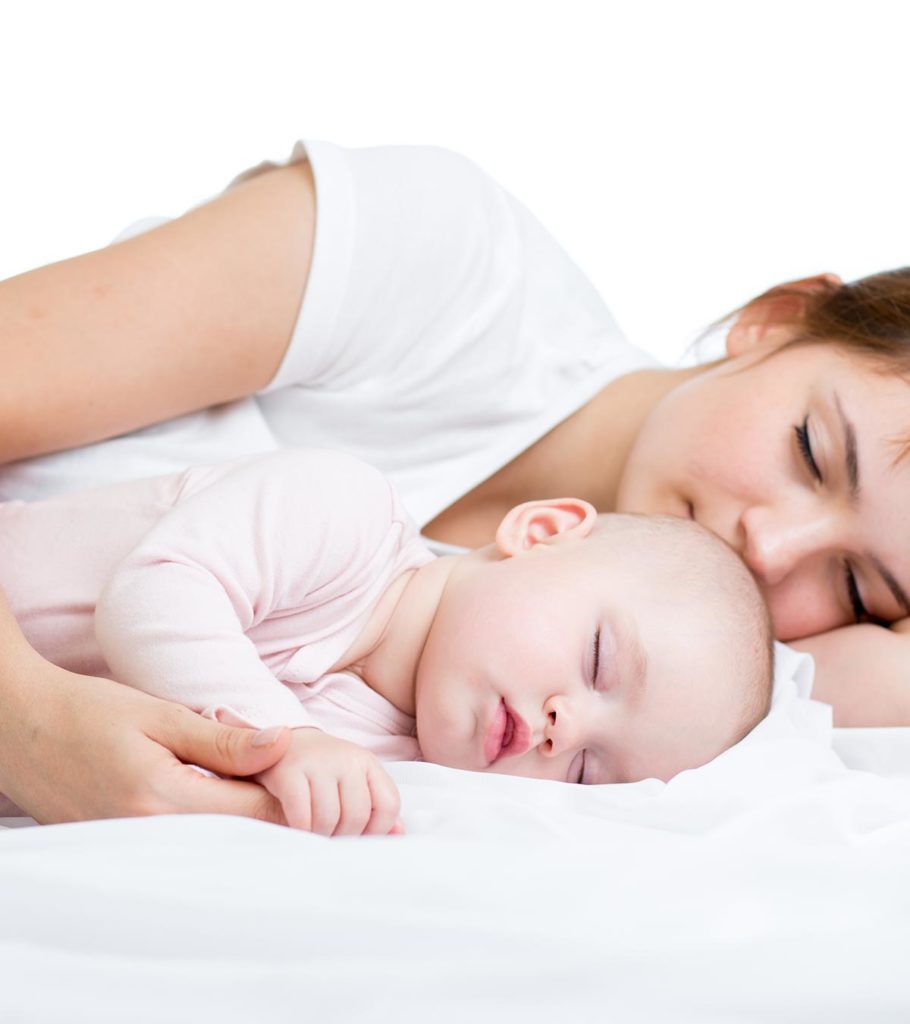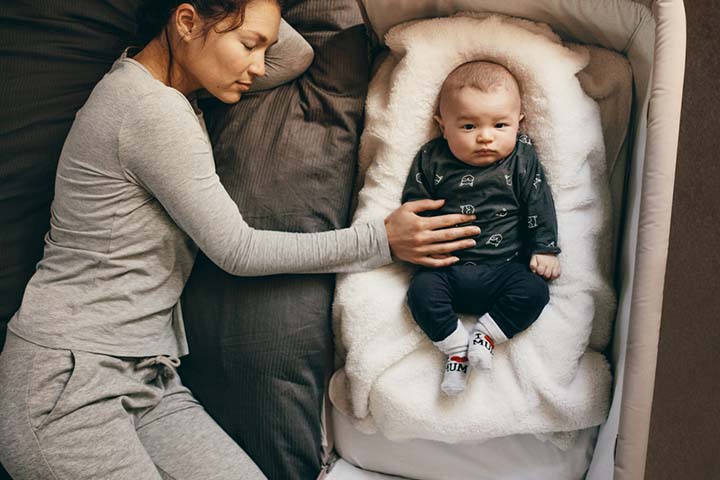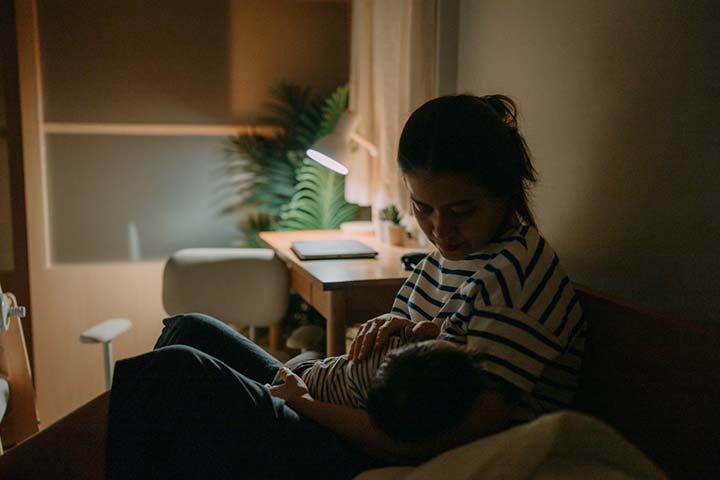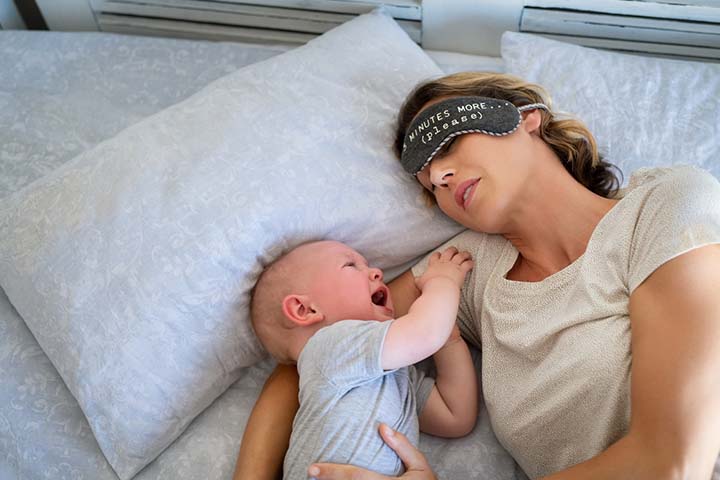In some cultures, co-sleeping with your baby is a responsible behavior, while in others, it is discouraged. However, if you’re having trouble with this and are looking for some tips for co-sleeping with your baby, this post may be helpful.
Co-sleeping is the practice of sharing your bed with your baby. It has several benefits, such as an improved bond between the parent and child, the child may feel safer, easier monitoring of the baby. However, some parents do not prefer the practice because of co-sleeping risks such as suffocating the child and unhealthy dependency on the parents.
However, if you plan to co-sleep, you should follow certain tips to ensure infant safety. Moreover, explore suitable products that make co-sleeping comfortable and safe.
This post offers information on the advantages and disadvantages of co-sleeping with your baby, the safety tips to remember, and ways to transition children from co-sleeping to a crib.
What Is Co-Sleeping With Baby?
Co-sleeping, also referred to as sleep-sharing, means to share a bed with your child. In simple words, co-sleeping is having a newborn, or an infant sleep with one or both the parentss (1). The different ways of co-sleeping are (2):
- Family bed or bed sharing: Where one or both the parents sleep with the child in the same bed.
- Different beds in the same room: Here, the baby sleeps in a crib or bassinet, or in the same room an arm’s away from the parents’ reach.
- Sidecar arrangement: The crib is attached to one side of the bed, next to the mother. This side can be removed or lowered so that it is easy to breastfeed the baby. You will also get commercial sidebar or co-sleeper cribs in the market.
- Baby welcomed when needed: The child is made to sleep in her bedroom and is taken when needed. Parents usually welcome their babies followed by a night waking.
Benefits Of Co-Sleeping With Your Baby
Though not suitable for every family, there are many co-sleeping benefits your family may have (2)(3).
- Research studies reveal babies are at a lower risk of sudden infant death syndrome (SIDS) when they sleep in the same room as parents. According to the American Academy of Pediatrics (AAP), the risk of sudden infant death syndrome (SIDS) decreases by 50% when parents use the room-sharing method instead of bed-sharing.
- It improves baby and maternal sleep quality and time. There is no need for you to wake up, get up from the bed and go to the baby to feed or comfort her.
- You willface fewer bedtime hassles.
- Your baby, if she is a toddler, feels secure and warm beside you.
- Breastfeeding during night time is easier.
- It will decrease the chances of nighttime separation anxiety.
- It facilitates sleep training when the sleep pattern of both the mother and the baby syncs and enables comfortable nursing.
- A fussy child can sleep better at night.
- A baby can fall asleep soon, and get back to sleep quickly if she wakes up in the middle of the night.
- It will be a great feeling to wake up next to a smiling and beautiful baby.
- Infants go through several feelings such as the warm touch of the mother, her movement, smell and comfort that would help in the overall infant development.
- You will be able to monitor the baby well during illnesses.
Anjali Kochhar Lipman, a mother and a primary Montessori teacher, shares that one of the reasons why she loves co-sleeping is because she never has to worry. She says, “Since my son was born, I’ve always known how his breathing sounds and whether or not it’s stable. I never worry that he’ll wake up fighting for air (like I’ve heard croup can do), and I won’t be there. If he’s sick, I usually know before he does. In the same way that he knows he’s safe because I’m there, so do I (i) .”
- You develop an attachment with the baby.
- Suits families with lesser space at home.
- Helps working mothers spend more time with their babies while sleeping, and gain a sense of intimacy and improved mother-infant bonding.
- There are no chances of the child falling from the bed.
- Sleep-sharing offers a safer sleep environment for children and helps them develop confidence.
- Not only the mothers but also the fathers will enjoy co-sleeping with their children, as it leads to a great bonding time and improved parent-infant relationship.
When there are so many benefits of co-sleeping, why do some families have their babies sleep separately?
Disadvantages Of Co-Sleeping With Your Baby
Some parents do not choose to co-sleep with their babies due to some potential risks (4) (5):
- Increased risk of infant mortality as babies can get strangled or suffocated due to a lack of enough space, especially young babies who lack enough motor skills to roll over or push away.
- Co-sleeping is known to promote unhealthy dependency on the parents.
- Some mothers complain of sleep deprivation as the constant or sudden movement of the child disturbs their sleep pattern. It can also affect the family’s sleep if everyone sleeps together.
- Co-sleeping can be risky if the parents have certain infectious health conditions.
- Co-sleeping should not be practiced if the parent is under any heavy medication or therapy.
- If either or both the parents have a habit of smoking, drug or alcohol abuse, then co-sleeping is known to pose severe health risks.
- Once the baby is used to sleeping with the parents, it will be difficult for her to sleep independently at a later point.
- Conditions like separation, divorce or death of any parent could leave the child in a deeply disturbing situation.
- The couple may be deprived of intimacy.
Is Co-sleeping With Your Baby Safe?
According to a research study, around 74% of the SIDS cases occurred in infants, aged up to four months, co-sleeping with their parents (6). However, the study did not take into account the smoking, drug, and drinking habits in parents.
The American Academy of Pediatrics (AAP) discourages parents from sharing the bed with their babies (7).
If you choose to co-sleep with your baby, you should follow co-sleeping safety guidelines to avoid fatalities.
Tips For Safe Co-Sleeping With Baby
When you want your baby to sleep with you, make sure you are following these safety measures (8):
1. Make baby sleep on her back:
Sleeping on the back lowers the risk of SIDS (9). If you have to nurse her while lying on the bed, and your baby is on the side, try to get her on the back after she finishes feeding.
2. Have an ideal sleep surface:
The mattress has to be firm with tightly placed bed sheets on it. Place one pillow, and a cotton blanket that does not fall over the baby’s face. Do not use a cushiony bed cover or sheepskins. Put your baby slightly higher on the bed, and you sleep a bit lower than her. For infants (below one year), it is advisable to use a firm mattress, fitted sheets, no pillows or blankets or toys.
3. Check the conditions around:
There have been cases of infants being squeezed between the mattress and a wall or furniture. Place your bed away from side furniture, walls, tables, etc., and there should be no gaps. An ideal place for the bed is the center of the room.
4. Say no to smoking and drinking:
Do not indulge in smoking when you are co-sleeping with your baby. Also, alcohol and drugs will make you less responsive, and you cannot attend to your baby. The same applies to your partner.
5. Keep it warm, not hot:
Co-sleeping can increase your baby’s body temperature. Leave her head uncovered to avoid a raise in the body temperature.
6. Dress up well:
Dress your baby in a proper night dress. For warmth, dress her in layers. Long sleeve dresses, footie pants, and sleep sacks could help. In summers, lighter clothes can provide infant comfort.
7. Manage feedings:
Make a consistent plan to regularize the feedings. Initially, feed your little one at regular intervals, and gradually shorten the feedings by a minute or so. You can also ask your partner to walk your baby around the room for infant soothing instead of feeding as the baby could wake up more frequently when she is co-sleeping with you.
8. Buy a big bed:
If co-sleeping is a routine in your home, consider buying a bigger bed. The more space you will have in bed, the better will be your sleep.
9. Do not co-sleep on an armchair or a sofa:
They are the most dangerous places that can make you fall asleep with the baby. Your little one could get squeezed in between the cushions or between you and the sides.
10. C position when sleeping:
Lie on one side facing your little one, and curl around her. Keep your lower arm over the baby’s head and bring your knees to her feet. Do not keep any pillows near the baby’s head. This is also the best position for nursing, as your baby’s lying level along your breasts can help her take the feed correctly.
Some parents use co-sleeper bassinets or separators to give babies their space. Though these contraptions are not required, they give parents assurance about their baby’s safety.
Products For Co-Sleeping
Here are some more products that you can use when sharing your bed with the baby:
- Bedside bassinets and bedside sleepers can be directly attached to the main bed, and are open on one side with barriers on all the other three sides.
- Bed top co-sleeping products prevent the baby from rolling away from the bed and help absorb breastmilk and other night time leaks.
- Infant enclosures are placed on the adult bed to prevent rollover, wedging and suffocation, thus ensuring safe newborn sleep.
- Side rails are fitted on either side of the bed to prevent the baby from rolling off the bed.
- Specially designed sleeping bags are separately available for parents and babies to prevent the covers from accidentally falling over the baby’s head.
When To Stop Co-Sleeping With Your Baby?
Transitioning your child from the bed to her space becomes difficult after six months of age due to firmly entrenched habits and expectations. However, regardless of the age, you can take the call depending on your priorities.
How To Transition Baby From Co-Sleeping To Crib?
Moving your baby from an adult bed to a crib is tricky. However, certain developmental changes during nine to 12 months help your child become independent and communicate better. Before this stage, she is likely to be clingy and fussy. Therefore, you may have to wait until this stage before you move her to a crib.
Try these tricks to shift your baby from the bed to the crib (10):
- Keep the baby near you: Use a bedside sleeper that is fixed to your bed but is separated from sleeping closely. This way your baby will get used to sleeping in her space, while still being close to you.
- Get the crib closer to her: Instead of directly putting the baby from your bed in her room, get the crib in your bedroom. Put her in the crib, and let her get adjusted to sleeping in her space. You can gradually place the crib in her room.
- Introduce in stages: Initially, make your baby sleep in the crib for naptime, and then as the days pass, make her sleep in the crib all the time. This way she will get used to it completely.
- Maintain a bedtime routine: Your baby may or may not be used to a night-time routine (a bath, a cuddle, reading a book or talking before she sleeps). Stick with the same ritual.
- Be around: Once you move your baby to the crib, comfort her until she settles in completely. Sit beside the crib to comfort her, and once she dozes off, move away slowly.
- Make the room special: Sometimes, babies get uneasy sleeping alone. Pick some attractive, bright colored bedcovers and dresses or sleep sacks. You can also choose some stuffed soft toys as a transitional object.
Co-sleeping with your baby is your personal choice. If you choose to co-sleep with your baby, following some precautions, such as keeping the baby on their back on a smooth, clutter-free surface, can help ensure their safety. You can co-sleep with your baby for as long as you desire. However, transitioning the baby from bed to crib is desirable to avoid difficulties later. To promote a smooth transition to the crib, keep the crib closer to you, place your baby in the crib during nap time, and stick to a routine.
Key Pointers
- Co-sleeping involves sharing the bed with your baby, which enhances bonding, allows for better monitoring, and increased safety.
- Research shows that co-sleeping reduces the likelihood of SIDS, enhances the quality of sleep for both the mother and baby, and minimizes bedtime troubles.
- The drawbacks of co-sleeping include the risk of suffocation or strangulation for the baby, unhealthy dependency, and difficulties sleeping independently.
- To ensure safe co-sleeping, use a firm and well-fitted mattress, avoid soft objects like pillows and blankets, and avoid sleeping with your baby on a couch or armchair.
Learn about the hazards associated with bed sharing and explore safe alternatives for co-sleeping with your baby. Acquire facts to make an informed decision for your family.















